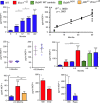Circulating levels of monocyte chemoattractant protein-1 as a potential measure of biological age in mice and frailty in humans
- PMID: 29290100
- PMCID: PMC5847863
- DOI: 10.1111/acel.12706
Circulating levels of monocyte chemoattractant protein-1 as a potential measure of biological age in mice and frailty in humans
Abstract
A serum biomarker of biological versus chronological age would have significant impact on clinical care. It could be used to identify individuals at risk of early-onset frailty or the multimorbidities associated with old age. It may also serve as a surrogate endpoint in clinical trials targeting mechanisms of aging. Here, we identified MCP-1/CCL2, a chemokine responsible for recruiting monocytes, as a potential biomarker of biological age. Circulating monocyte chemoattractant protein-1 (MCP-1) levels increased in an age-dependent manner in wild-type (WT) mice. That age-dependent increase was accelerated in Ercc1-/Δ and Bubr1H/H mouse models of progeria. Genetic and pharmacologic interventions that slow aging of Ercc1-/Δ and WT mice lowered serum MCP-1 levels significantly. Finally, in elderly humans with aortic stenosis, MCP-1 levels were significantly higher in frail individuals compared to nonfrail. These data support the conclusion that MCP-1 can be used as a measure of mammalian biological age that is responsive to interventions that extend healthy aging.
Keywords: CCL2; biological age; biomarkers of aging; chemokine; geropathology; monocyte chemoattractant protein-1.
© 2017 The Authors. Aging Cell published by the Anatomical Society and John Wiley & Sons Ltd.
Figures


References
-
- Akdogan M. F., Azak A., Denizli N., Huddam B., Kocak G., Gucun M., … Duranay M. (2015) MCP‐1 and soluble TWEAK levels are independently associated with coronary artery disease severity in patients with chronic kidney disease. Renal Failure 37, 1297–1302. https://doi.org/10.3109/0886022X.2015.1065428 - DOI - PubMed
-
- Baker D. J., Childs B. G., Durik M., Wijers M. E., Sieben C. J., Zhong J., … van Deursen J. M. (2016) Naturally occurring p16(Ink4a)‐positive cells shorten healthy lifespan. Nature 530, 184–189. https://doi.org/10.1038/nature16932 - DOI - PMC - PubMed
-
- Baker D. J., Wijshake T., Tchkonia T., LeBrasseur N. K., Childs B. G., van de Sluis B., … van Deursen J. M. (2011) Clearance of p16Ink4a‐positive senescent cells delays ageing‐associated disorders. Nature 479, 232–236. https://doi.org/10.1038/nature10600 - DOI - PMC - PubMed
-
- Barzilai N., Crandall J. P., Kritchevsky S. B., Espeland M. A. (2016) Metformin as a Tool to Target Aging. Cell Metabolism 23, 1060–1065. https://doi.org/10.1016/j.cmet.2016.05.011 - DOI - PMC - PubMed
Publication types
MeSH terms
Substances
Grants and funding
LinkOut - more resources
Full Text Sources
Other Literature Sources
Medical
Molecular Biology Databases
Research Materials
Miscellaneous

